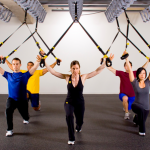Have you lately heard the terms TRX or suspension training and wondered what they meant? TRX stands for total resistance exercise and suspension training is a system of exercise that utilizes your body weight leveraged against gravity to create resistance. TRX suspension training was born out of necessity by navy seals to stay in peak physical condition while on missions where training space and equipment was at a premium. Because of its versatility, TRX suspension training is now utilized in a wide range of settings from training professional athletes to senior citizen wellness programs, and injury rehabilitation at RI Limb Prosthetics, Orthotics And Physical Therapy.
How does TRX suspension training work?
Suspension training uses the basic principles of physics including pendulums, vectors, and gravity to create resistance with one’s body weight. The exercise intensity is determined by alterations in two variables: resistance and stability. Changing the body angle alters the resistance. Changing the foot position alters the stability. Therefore, exercise progression occurs by increasing body angle to increase the resistance, or narrowing of foot position to decrease the stability. These simple principles make suspension training exercises safe and effective for people of all ages, mobility, and ability.
I would like to share two TRX phrases to highlight why suspension training is so effective in rehabilitation. The first is “Train in 3-D” or “Train movement, not muscle.” TRX suspension training trains the body to move freely through space in coordinated movement patterns. All TRX exercises build upon 6 functional movements used in daily life: squatting, lunging, stepping, pushing, pulling, and twisting. Therefore, all exercises performed on the TRX suspension trainer directly help the body to develop strength, mobility, balance, coordination, and endurance to perform these daily activities more safely and efficiently.
The second phrase is “All core. All the time.” TRX suspension training and physical therapy rehabilitation are both based upon the principle that core stability is necessary and prerequisite for safe, effective mobility in the arms and legs. The TRX exercises are designed to promote movement from the core by displacing one’s center of gravity outside their base of support. In doing this, the core is activated with every exercise to return the body to an upright position. Displacing the center of gravity challenges one’s balance and stability. By moving through gravity in this way, these exercises teach the core to work in functional activities so we are able to move more efficiently through space in daily life.
In conclusion, TRX suspension training fits perfectly into the spectrum of physical therapy rehabilitation. It is safe and effective for all people because exercise intensity can be modified based upon individual ability. It trains the body to move more efficiently by activating core musculature with all exercises and utilizing functional movement patterns necessary for daily living. If you are interested in learning more about TRX training contact us at RI Limb Prosthetics, Orthotics And Physical Therapy — (401) 884-9541.
Contributed by: Ericka Fryburg, MSPT

